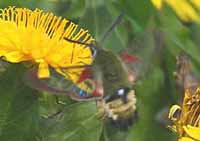Sphinginae subfamily
Sphingini tribe:
 |
This species is likely present (reported in Yakima) and larvae feed
on tomatoes and go by the common name of
"Tomato Hornworms". |
 |
Sphinx chersis WO, the Northern Ash Sphinx or Great Ash Sphinx
The upperside of the forewing is soft dark gray to blue-gray with
a series of black dashes, one of which reaches the wing tip. |
 |
Although not reported from Klickitat (reported in Yakima), I suspect it is present.
I only see them occasionally on P.E.I. despite visiting lights frequently. |
 | The upperside of the forewing is dark grey to black with a
paler costa and pale area from the base to the wing's centre.
Prefered habitats include montane woodlands and mixed chaparral-type
vegetation. Reported in Yakima. |
 |
Sphinx vashti
USGS, the Snowberry Sphinx
The upperside of the forewing has a narrow black subterminal line
bordered by a white inverted V-shaped line on the outside, and a
black line running inwards from the apex of the wing.
It is most often found in montane woodlands and along streamcourses. |
Smerinthini Tribe:
 |
This one is quite similar to Pachysphinx modesta, with modesta
being smaller and darker.
If you've got willows or poplars nearby, then you probably have
occidentalis in your immediate area.
|
 |
The grey-blue eyespot of the hindwing gives this species its name.
Larvae feed on birches, willows, cherries and oaks.
The outer edge of the forewings is quite scalloped. |
 | Larvae feed on poplars, aspen and willows.
Note different shape of double arced forewing pm line compared to the straighter pm line of cerisyi, which it replaces in WA.
S. ophthalmica has smoother scalloping of the fw outer margin.
|
Macroglossinae subfamily
Dilophonotini tribe
 |
Hemaris diffinis WO, the Snowberry Clearwing or Bumblebee Moth
Although not officially reported from Klickitat, this day flying moth
is widely distributed in Washington (Yakima +).
I suspect I will get reports from Klickitat County. |
 |
Hemaris senta USGS Rocky Mountain
clearwing
This report from USGS may be in error as this moth (a day flier in mountain meadows) is easily confused
with Hemaris diffinis. Klickitat is the only county reported in WA. or OR. |
Macroglossini tribe
 |
Hyles gallii WO,
the Bedstraw Hawk Moth or Gallium Sphinx
This species is not officially reported from Klickitat County, but if you have
Gallium or Epilobium, you probably have populations of
this species. |
 |
Hyles lineata DM, the White-lined
Sphinx
Dave McNeese reports this species. It can be seen flying during the
day, into the evening and also at night.
The highly variable larvae are often found in people's gardens. |
Hyles lineata: Dave McNeese
DM, mile post 119 on Hwy. 14,
Goldendale, 3:30 p.m., May 22
 |
Now officially reported from Klickitat County, this day
flier, April-June, prefers oak woodland and pine-oak woodland in
foothills. Moths nectar at a variety of flowers
in the afternoon.
|
Proserpinus clarkiae: May 11, 1997, Larry Gooding LG reports a
sighting (moth nectaring at flowers) at mid-day, east of Lyle: leave Hwy 14 at milepost 77 and
hike on "Cherry Orchard Trail", an unofficial trail. Oak scrub and
grassland.
 |
Proserpinus flavofasciata WO,
the Yellow-banded Day Sphinx
This species is not officially reported from Klickitat, but it is
found to the north, east and south and
may be present. It nectars during the day in meadows near coniferous forests. |
|
|
